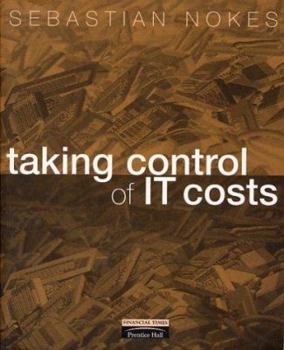Taking Control of It Costs: A Business Managers Guide
IT budgets are regularly overspent for two reasons. Firstly, managers don't feel that they have sufficient technical knowledge to understand IT costs and mangage them properly. Secondly, most internal... This description may be from another edition of this product.
Format:Paperback
Language:English
ISBN:0273649434
ISBN13:9780273649434
Release Date:March 2000
Publisher:Addison Wesley Longman
Length:224 Pages
Weight:0.88 lbs.
Dimensions:0.5" x 7.5" x 9.2"
Customer Reviews
2 ratings
Refreshingly practical and achievable approach
Published by Thriftbooks.com User , 22 years ago
This is a no-nonsense, straightforward approach to establishing and keeping control of IT costs. The author shows IT managers how to employ proven cost management techniques that operational lines of business use to understand IT costs and to make sound business decisions with respect to managing IT budgets and expenditures.The first step is to analyze cost management, and the book provides a three-step healthcheck to help you to get a handle on this aspect. Second, you are shown how to trace cost allocations in a manner that borrows heavily from activity-based cost management techniques. The next step in the book's approach is to develop a strategy and supporting tactics for achieving efficiency. Then chapter on key performance indicators and benchmarking shows you what you should be measuring and how to compare your cost management posture with industry norms for your industry segment. This chapter also gives caveats about benchmarking to which you should pay close attention if you are new to benchmarking or frameworks because it's easy to lose sight of the objectives (cost management) when you're exploring this aspect of management. The book concludes with chapter that goes deeper into strategic planning, and two invaluable appendices on accounting techniques and typical cost structures.What I particularly like about this book is there is no theory, silver bullets or preaching. It gives an approach that is not only achievable, but is consistent with standard practices in cost management in and out of thr IT domain.
Highly readable and filled with excellent information
Published by Thriftbooks.com User , 23 years ago
My reason for reading this book was to get some ideas about how to control IT costs from an asset management point of view that I could incorporate into a comprehensive set of processes to be integrated into contact center management. Contact centers, also known as IT help desks, usually employ software that manage problems. The more sophisticated software also includes modules for service level management, change control and asset management. Taken together these form the foundation of service delivery and support - both of which are costly. As I read through this book I began to gain a wider view of how to go about analyzing service delivery and support costs through a systematic analysis of cost allocations. The three IT expense health checks in chapter 2 were immediately useful because they addressed key performance indicators that show how well costs are managed, the impact standardization has on controlling costs, and the importance of gaining control over physical assets (this is directly related to my original reason for reading the book). Another gem I gleaned from this book is the fact that fixed costs are like a shell game - there is an apportionment of fixed costs, which are finite and driven by a budget, among functional areas. The trick is to make sure that the budget for fixed costs is apportioned in accordance with the importance of the areas to which they are targeted. Also interesting is the premise that budgets should be based on a mix of short- and long-term initiatives, which is different from common practice in that too often budgets are allocated to initiatives strictly based on priority or perceived importance.This book deals with strategy as much as cost control, which is logical since both have some obvious relationships. Here too the book contained some excellent advice, the most sensible of which is that methodologies are not as important to a strategy as understanding the strategic issues and building an integrated team. This applies to both projects and operations, and should be carefully considered by anyone who rushes out to buy the latest tools (most of which lock you into a methodology) before thinking through the real goals and objectives. The two appendices were invaluable resources for reviewing accounting principles and giving a complete cost breakdown structure that is typical of most IT organizations.





